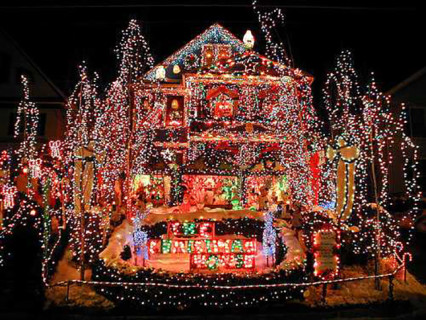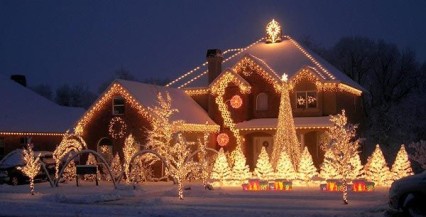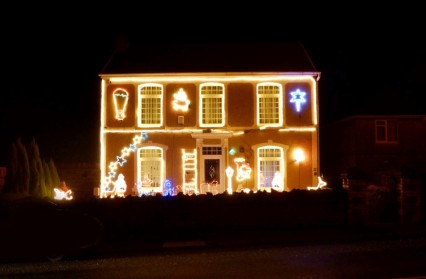Lighting up for Christmas is a regular activity for most households during the festive period, though some argue that the activity should be avoided. The architect, Richard Porch offers a defence for the popular festive activity.
There are few American contributions to the great British Christmas that spring to mind. That allows for Washington Irving (1783 – 1859) to be the real inventor of the Victorian Christmas. Don’t believe me? You obviously haven’t read The Sketch Book of Geoffrey Crayon Gent. published in 1820, a full 23 years before Dickens wrote A Christmas Carol. Read the self-explanatory chapters; Christmas, The Stage Coach, Christmas Eve and Christmas Day, and discover the Victorian Christmas in its embryonic late-Georgian form. Dickens knew and admired this book and correspondence between the two authors have survived to prove it. Nevertheless, it took Dickens to take the idea of using Christmas as a fit subject to write a whole novel around and then take it a step further by injecting time travel (the ghosts of Christmas past, present and future, etc.) into the plot.
However, the advent (sorry) of externally-mounted Christmas lights festooned all over one’s house is one imported fashion I heartily approve of. In fact, I adore them. Whether they depict a dodgy-looking Santa climbing a flimsy plastic ladder or merely some form of highly stylised snowflake strobing away like crazy, they are okay by me.
 Why? They are a free civic light show mounted by the public for the public and without any reward in mind. It doesn’t cost the council anything because the householder foots the bill for the purchase, installation and running costs of the display. The result fills our drab winter streets with flickering coloured displays visible from miles away and adds to the gaiety of the season. You have to be a bit of a curmudgeon not to like them. They brighten up the longest and darkest evenings of the year with a tacky vitality.
Why? They are a free civic light show mounted by the public for the public and without any reward in mind. It doesn’t cost the council anything because the householder foots the bill for the purchase, installation and running costs of the display. The result fills our drab winter streets with flickering coloured displays visible from miles away and adds to the gaiety of the season. You have to be a bit of a curmudgeon not to like them. They brighten up the longest and darkest evenings of the year with a tacky vitality.
I’m not sure when the idea of attaching lights to the exterior of one’s home became an extension of the Christmas festivities in the UK. From memory, I think it started to kick in around 10 years ago and (somewhat inevitably) gained currency via a series of American films. Perhaps the Home Alone film franchise had something to do with it. Until then I think British homes mainly confined themselves to tastefully decorated Christmas trees in front windows, some tinsel taped around the window frame and the odd display of Christmas cards. How tame. To the English, I daresay the whole ‘to decorate’ or ‘not to decorate’ reignites the whole ‘U’ or ‘Non-U’ debate. I wonder if any academic research has been done into which social class tends to decorate the exterior of their house most; is it predominantly a working-class thing? Do the middle classes go in for it or what?

The very fact that not everyone goes in for decorating their house gives the ones that do so much impact. One is almost tempted to think of them as some form of folk art. They aren’t of course; because all the designs are bought off the shelf and there’s little skill involved, the only choice. It could be argued that the positioning of them on the house and the consequent extent or quality of illumination involves some sort of aesthetic judgement, but I can’t buy it… much as I’d like to. Although just how many decorations you apply to your house, consciously or unconsciously tells the world something about you. Used minimally they can verge on the elegant – overused and you risk a manic overkill that suggests either love of Christmas or a simple craving for attention. Perhaps that’s it. Perhaps they are just another aspect of the blasted ‘me generation’. The Twitter account and the Facebook blog are fine; but they are only digital soapboxes and, given that every second nuisance has one or the other these days, they do not stake you out in any way as ‘special’. However, covering your house in Christmas lights – that must mean you really are special or distinctive.
Okay, I take that back. That was both cynical and curmudgeonly – as I said earlier I adore these altruistic interventions by private citizens. They temporarily ‘improve’ a fragment of the environment and illuminate the winter dark. Local newspapers should hold competitions to see who has the best-decorated house. Now, what aesthetic yardsticks would you use to define ‘best’? Notice I didn’t say the ‘most’ decorated house – that’s just asking for trouble. In Wales, the way such lights work is by breaking up the regimented rows of terraced houses. Whether it is a line of ‘icicles’ dangling precipitously from the roof eaves or some ill-proportioned reindeer improbably rendered in winking lights, they alter our perception of the building. The ‘dazzle’ effect they bring to a property mimics the effect of the original camouflage technique. By that I mean they bend shape and distort mass to great effect turning a house into a background canvas for a kinetic display using Christmas as the theme.
Bah, humbug.
Richard Porch is an architect and regular contributor to Wales Arts Review.
For other articles included in this collection, go here.











